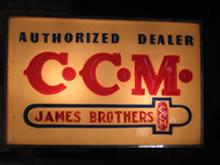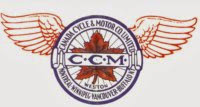Recent comments
-
Reply to: 60's Rambler?
Both the one piece and three piece styles of head tubes assemblies existed concurrently for over a century. Consequently, the use of one style over the other is not timeline related. Rather, it's a cost based decision, with the three piece style typically being used on more expensive bicycles and the one piece style being employed on lower priced bicycles.
In the three piece style, the fittings used to connect the frame tubes to the head tube are referred to as "lugs". The traditional way to manufacture both the one piece head tube assembly and lugs was the same. You stamp out the shape, then form it and weld it. There's not much difference in the material costs between the two methods but there is a big difference in labour costs since it takes almost twice as long to manufacture two lugs. Then when you go to assemble the frame there's twice as much brazing and clean-up due to the separate head tube, which are costly, labour intensive processes. Around the early 1960s, bulge forming was adopted to manufacture the one piece style, which made it even less expensive.
Also, since lugs were used on more expensive models, manufacturers started to dress up the lugs to justify the extra cost to the consumer. The designs can be quite elaborate with extensive edge sculpting, cut-outs, chrome plating, contrasting colours, and/or pinstriped outlines. The one piece style can also be dressed-up but due to their target price level, its typically quite mild. Consequently, by comparison, the one piece style looks rather plain and to the average consumer the lugged head tubes look more expensive. This subconsciously justifies the extras cost and leads to the impression that it is the superior style. In fact, they do have some marginal advantages but besides the aesthetics, they're inconsequential to the typical consumer.
Both styles gradually died out during the last two decades of the 20th century, though the lugged style is still produced by some custom, high end frame builders. Currently, all levels of the market for metal frames are dominated by welded frames, wherein the frame tubes are directly joined to the head tube.
If you looked at CCM's model lines for both the Rambler 500 era (1966-1967) and the Seville era (1978-1980) you'll find both styles and that they indicate the relative positions of these models in the product lines for their eras.
-
Reply to: 60's Rambler?
I'll have a look for the j or h code on the opposite rear fork end (it's good to know the correct name). Thank you for the response, I really appreciate it. I can see how this vintage bike collecting could become addictive!
Another question- Is there any time frame or correlation of age when it comes to headtube construction? I have noticed several different designs. 3 pieces, two fitttings and a tube connecting them or like my bike where it looks as though the whole headtube was possibly stamped in one piece, bent around a mandrel then brazed or welded, or like my son's Seville, very fancy fittings.
-
Reply to: 60's Rambler?
CCM introduced its progressive (a.k.a. shark nose) chainguard for the 1966 model year, which was also the last year for the post-war metal headbadge and that fork style. The 1966 Imperial 700 came with chrome plated fenders and a chainguard that was colour matched to the frame so, assuming the chainguard is orignal, this should be a 1966 Rambler 500.
In my experience, CCM did not employ a different serial number format for customer brands, so the missing alpha character would appear to be a simple case of employee error. Having said that, I've seen cases where the year indicator appears to have been batch stamped, in advance of building the frame and stamping the serial number. Consequently, if the framebuilder inadvertently switched the dropouts, it's possible that the alpha character could be on the inside of the drive side dropout (technically, when the axle slot opens to the rear, it's called a "rear fork end", as the wheel can only "drop out" when the opening is towards the front and/or bottom). A 1966 model built in late 1965 would have an H-code, while one built in the 1966 calendar year would have a J-code.
-
Reply to: 60's Rambler?
The rear hub appears to be a Sturmey Archer or Perry with no markings. The internals are identical and the axle has a squared end. The serial number is quite baffling though. I have checked and rechecked it to see if I wasn't missing a letter somewhere. I wonder if it was stamped with a clients serial number (like supercycle) and accidentally built up as a CCM. The headbadge rivets look to be original and I doubt someone would try to fake a supercycle for a ccm as there really isn't any reason to.
-
Reply to: 60's Rambler?
Doesn't appear that my pics attached




